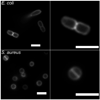Zinc(II) coordination complexes as membrane-active fluorescent probes and antibiotics
- PMID: 18076009
- PMCID: PMC2849105
- DOI: 10.1002/cbic.200700489
Zinc(II) coordination complexes as membrane-active fluorescent probes and antibiotics
Abstract
Molecular probes with zinc(II)-(2,2'-dipicolylamine) coordination complexes associate with oxyanions in aqueous solution and target biomembranes that contain anionic phospholipids. This study examines a new series of coordination complexes with 2,6-bis(zinc(II)-dipicolylamine)phenoxide as the molecular recognition unit. Two lipophilic analogues are observed to partition into the membranes of zwitterionic and anionic vesicles and induce the transport of phospholipids and hydrophilic anions (carboxyfluorescein). These lipophilic zinc complexes are moderately toxic to mammalian cells. A more hydrophilic analogue does not exhibit mammalian cell toxicity (LD(50) >50 microg mL(-1)), but it is highly active against the Gram-positive bacteria Staphylococcus aureus (MIC of 1 microg mL(-1)). Furthermore, it is active against clinically important S. aureus strains that are resistant to various antibiotics, including vancomycin and oxacillin. The antibiotic action is attributed to its ability to depolarize the bacterial cell membrane. The intense bacterial staining that was exhibited by a fluorescent conjugate suggests that this family of zinc coordination complexes can be used as molecular probes for the detection and imaging of bacteria.
Figures








Similar articles
-
Imaging and therapeutic applications of zinc(ii)-dipicolylamine molecular probes for anionic biomembranes.Chem Commun (Camb). 2016 Jul 7;52(57):8787-801. doi: 10.1039/c6cc03669d. Chem Commun (Camb). 2016. PMID: 27302091 Free PMC article. Review.
-
Selective recognition of bacterial membranes by zinc(II)-coordination complexes.Chem Commun (Camb). 2006 Apr 21;(15):1595-7. doi: 10.1039/b517519d. Epub 2006 Feb 16. Chem Commun (Camb). 2006. PMID: 16582990
-
Phenoxide-Bridged Zinc(II)-Bis(dipicolylamine) Probes for Molecular Imaging of Cell Death.Bioconjug Chem. 2016 Feb 17;27(2):363-75. doi: 10.1021/acs.bioconjchem.5b00447. Epub 2015 Sep 11. Bioconjug Chem. 2016. PMID: 26334386 Free PMC article.
-
Transcriptional induction of the penicillin-binding protein 2 gene in Staphylococcus aureus by cell wall-active antibiotics oxacillin and vancomycin.Antimicrob Agents Chemother. 2003 Mar;47(3):1028-36. doi: 10.1128/AAC.47.3.1028-1036.2003. Antimicrob Agents Chemother. 2003. PMID: 12604538 Free PMC article.
-
The rationale for revising the Clinical and Laboratory Standards Institute vancomycin minimal inhibitory concentration interpretive criteria for Staphylococcus aureus.Clin Infect Dis. 2007 May 1;44(9):1208-15. doi: 10.1086/513203. Epub 2007 Mar 28. Clin Infect Dis. 2007. PMID: 17407040 Review.
Cited by
-
Application of metal coordination chemistry to explore and manipulate cell biology.Chem Rev. 2009 Oct;109(10):4921-60. doi: 10.1021/cr900134a. Chem Rev. 2009. PMID: 19715312 Free PMC article. Review. No abstract available.
-
Optical imaging of bacterial infections.Clin Transl Imaging. 2016;4:163-174. doi: 10.1007/s40336-016-0180-0. Epub 2016 May 4. Clin Transl Imaging. 2016. PMID: 27340649 Free PMC article. Review.
-
Imaging and therapeutic applications of zinc(ii)-dipicolylamine molecular probes for anionic biomembranes.Chem Commun (Camb). 2016 Jul 7;52(57):8787-801. doi: 10.1039/c6cc03669d. Chem Commun (Camb). 2016. PMID: 27302091 Free PMC article. Review.
-
Evaluation of [¹¹¹In]-labeled zinc-dipicolylamine tracers for SPECT imaging of bacterial infection.Mol Imaging Biol. 2015 Apr;17(2):204-13. doi: 10.1007/s11307-014-0758-8. Mol Imaging Biol. 2015. PMID: 25115869 Free PMC article.
-
Optical imaging of bacterial infection in living mice using deep-red fluorescent squaraine rotaxane probes.Bioconjug Chem. 2010 Jul 21;21(7):1297-304. doi: 10.1021/bc1000998. Bioconjug Chem. 2010. PMID: 20536173 Free PMC article.
References
-
- Choi S-K. Synthetic Multivalent Molecules, Concepts and Biomedical Applications. Hoboken: Wiley; 2004.
-
- Howard GC, Kaser MR, editors. Making and Using Antibodies: A Practical Handbook. Boca Raton: CRC Press; 2006.
- Mather SJ. Mol. Biosyst. 2007;3:30–35. - PubMed
-
- Dübel S, editor. Handbook of Therapeutic Antibodies. Weinheim: Wiley-VCH; 2007.
-
- Tew GN, Clements D, Tang H, Arnt H, Scott RW. Biochim. Biophys. Acta. 2006;1758:1387–1392. - PubMed
- Epand RF, Schmitt MA, Gellman SH, Epand RM. Biochim. Biophys. Acta. 2006;1758:1343–1350. - PubMed
- Rausch JM, Marks JR, Wimley WC. Proc. Natl. Acad. Sci. USA. 2005;102:10511–10515. - PMC - PubMed
- Odds FC, Brown AJP, Gow NAR. Trends Microbiol. 2003;11:272–279. - PubMed
Publication types
MeSH terms
Substances
Grants and funding
LinkOut - more resources
Full Text Sources
Other Literature Sources
Medical
Research Materials
Miscellaneous

